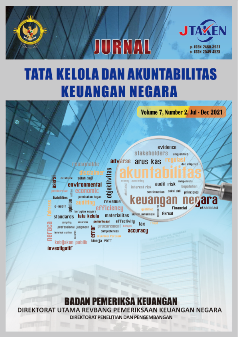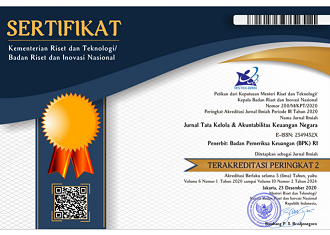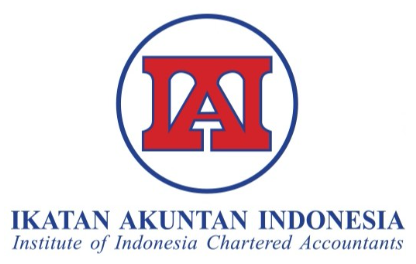The Implementation of Benford's Law to Detect Indications of Corruption Patterns in Government Institutions
DOI:
https://doi.org/10.28986/jtaken.v7i2.740Keywords:
Benford's Law, corruption, cash expenditures, year-end rush, hurry-up spendingAbstract
Disclosure of corruption cases requires a collaboration of experts in law, accounting, and auditing. In Indonesia's context, corruption patterns in government institutions can be identified based on the types of expenditure and the timing of cash disbursements. This study aims to reveal the indications and patterns of corruption in Indonesian government institutions. This study uses data on cash disbursements to detect indications and patterns of corruption. The first-digit, second-digits and first-two-digits digital analysis methods based on Benford's law were employed to analyze the data. This study found differences in cash disbursement transactions data value and Benford's law value. Furthermore, this study also discovers that corruption in government institutions follows a pattern in which corruptions often occur in the procurement of goods/services, purchases of food and beverage, and miscellaneous payments. The indications of corruption transpire throughout the year and show an increase at the end of the year (i.e., October to December), suggesting a 'year-end rush' and a phenomenon of 'hurry-up spending' in government institutions. Another pattern is related to digit groups of 30, 50, 60, and 90 committing corruption through cash disbursement transactions deliberately.
References
ACFE. (2016). Report to the nations on occupational fraud and abuse. Retrieved from https://www.acfe.com/rttn2016/docs/2016-report-to-the-nations.pdf
ACFE Indonesia Chapter. (2020). Survei fraud Indonesia 2019. Jakarta: ACFE Indonesia Chapter. Retrieved from http://acfe-indonesia.or.id/wp-content/uploads/2017/07/SURVAI-FRAUD-INDONESIA-2016.pdf
Arkan, M. M. (2010). Analisis penggunaan Benford’s Law dalam perencanaan audit pada Direktorat Jenderal Bea dan Cukai. Simposium Nasional Akuntansi XIII, 1–22.
Bwarleling, T. H. (2011). Pendeteksian fraud dengan hukum Benford. Jurnal Akuntansi Bisnis, 4(2), 56–74.
Cella, R. S., & Zanolla, E. (2018). Benford’s law and transparency: An analysis of municipal expenditure. Brazilian Business Review, 15(4), 331-347. DOI: 10.15728/bbr.2018.15.4.2
Douglas, J. W., & Franklin, A. L. (2006). Putting the brakes on the rush to spend down end-of-year balances: Carryover money in Oklahoma State Agencies. Public Budgeting & Finance, 26(3). 46-64. DOI: 10.1111/j.1540-5850.2006.00854.x
Durtschi, C., Hillison, W., & Pacini, C. (2004). The effective use of Benford’s Law to assist in detecting fraud in accounting data. Journal of Forensic Accounting, V, 17–34.
Indriati, E. (2014). Pola dan akar korupsi. Jakarta: Gramedia Pustaka Utama.
Juwono, V., & Mayasari, I. (2019). Pola korupsi pemerintah daerah dan pimpinan transformasional. Publik Bicara. Retrieved from https://www.kpk.go.id/id/berita/publik-bicara/782-pola-korupsi-pemerintah-daerah-dan-pimpinan-transformasional.
KPK. (2018). TPK berdasarkan jenis perkara. Retrieved from https://acch.kpk.go.id/id/statistik/tindak-pidana-korupsi/tpk-berdasarkan-jenis-perkara.
Kuruppu, N. (2019). The Application of Benford’s Law in fraud detection: A systematic methodology. International Business Research, 12(10), 1–10.
Lanham, S. W. (2019). Analyzing big data with Benford’s Law: A lesson for the classroom. American Journal of Business Education (AJBE), 12(2), 33–42. DOI: 10.19030/ajbe.v12i2.10285
Mujiono. (2012). Pemanfaatan spreadsheet Microsoft Excel untuk pembelaran Benford’s Law pada analisa data transaksi BBM bersubsidi. Konferensi Nasional Pembelajaran Informatika, 50–55.
Murhaban, M., & Jufrizal, J. (2017). Analisis penggunaan Benford's Law dalam perencanaan audit di Direktorat Jenderal Bea dan Cukai Cabang Kota Lhokseumawe. Jurnal Akuntansi dan Keuangan, 5(1), 39–50.
Musriaddin., Abdullah, M., & Asni, N. (2018). Efektivitas pengguna Benford’s Law dalam mendeteksi kecurangan laporan keuangan pada perusahaan yang terdaftar di Bursa Efek Indonesia. (Skripsi). Universitas Halu Oleo Kendari, Indonesia.
Nigrini, M. J. (2012). Benford’s Law: Applications for forensic accounting, auditing, and fraud detection. New Jersey: John Wiley & Sons, Inc.
Nugroho, H., Raharjo, A., & Pranoto. (2015). The optimization of corruption prevention towards Indonesia is corruption-free. Jurnal Dinamika Hukum, 15(3), 239-244.
Prabowo, H. Y. (2014). To be corrupt or not to be corrupt: Understanding the behavioral side of corruption in Indonesia. Journal of Money Laundering Control, 17(3), 306-326. DOI 10.1108/JMLC-11-2013-0045
Prasetyo, K. A., & Djufri, M. (2020). Penggunaan Benford’S Law untuk menentukan prioritas audit pajak pertambahan nilai. Scientax Jurnal Kajian Ilmiah Perpajakan Indonesia, 1(2), 167–183.
Restianto, Y. E., & Bawono, I. R. (2011). Audit sistem informasi menggunakan active data for excel. Yogyakarta: Penerbit Andi.
Setyawan, E. C. (2020). The use Benford’s Law in performance audit to detect fraud in the state expenditure transactions assisted by IDEA software (A case study at the Transportation Ministry Work Units). Asia Pacific Fraud Journal, 5(1), 147–159. DOI: 10.21532/apfjournal.v5i1.145
Shein, M., & Lanza, R. (2009). Fraud detection with active data for excel ebook. Canada: Information Active Inc.
Shofy, M. A. (2016). Penggunaan Benford Law untuk pendeteksian fraud di Hotel ABC. Jurnal Ilmiah Mahasiswa FEB Universitas Brawijaya, 4(2), 1-20.
Singleton, T. W., & Singleton, A. J. (2010). Fraud auditing and forensic accounting. Fourth Edition. New Jersey: John Wiley & Sons, Inc.
Tota, I., Aliaj, A., & Lamçja, J. (2016). The use of Benford’s Law as a tool for detecting fraud in accounting data. Interdisciplinary Journal of Research and Development, 3(1), 73-77.
U.S. General Services Administration. (2012). Procurement fraud handbook. Retrieved from https://www.gsaig.gov/sites/default/files/misc-reports/ProcurementFraudHandbook_0.pdf
Wijaya, I. F. (2013, Januari 14). Minimnya daya serap anggaran. Media Online Gagasan Hukum. Retrieved from https://gagasanhukum.wordpress.com/tag/minimnya-daya-serap-anggaran.

Downloads
Submitted
Accepted
Published
How to Cite
Issue
Section
License

Jurnal Tata Kelola dan Akuntabilitas Keuangan Negara is licensed under
a Creative Commons Attribution-ShareAlike 4.0 International License




















